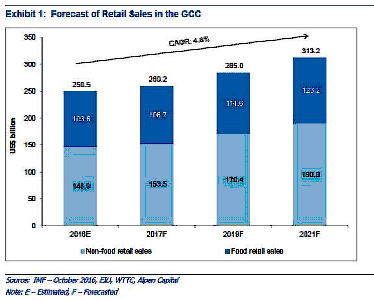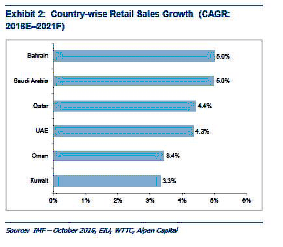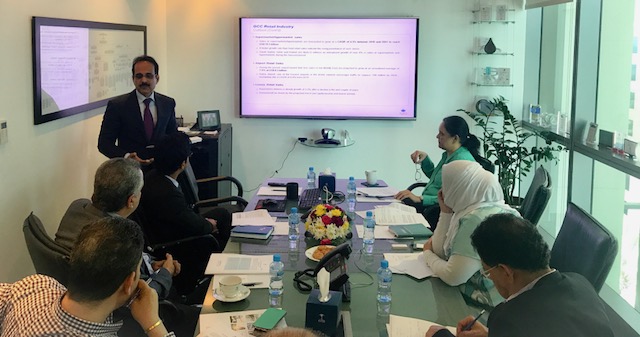The GCC retail industry’s long term fundamentals remain strong despite recent slowdown says Alpen Capital’s new report
All GCC locations, 22nd May, 2017
Alpen Capital, an investment banking advisory firm, announced the publication of its report on the GCC Retail Industry. The report presents an overview of the retail landscape in the GCC as well as a synopsis of the demand-supply dynamics of the industry. The report also covers recent trends, growth drivers and challenges of the retail sector in the region. Finally, it profiles some of the renowned retail companies in the GCC.
“The GCC retail sector continues to remain an active contributor to the region’s economic development. Although the sector is experiencing a slowdown, the long-term fundamentals of the sector remain strong and are expected to grow steadily through 2021. A favorable demography, high per capita income and an active tourism industry have attracted renowned international retail brands to the GCC. Changing consumer preferences and proliferation of digital devices are further reforming the region’s retail landscape. The numerous mall developments in the pipeline and growing penetration of modern store formats are a testament to immense opportunities in the sector. Furthermore, government efforts to encourage foreign investments, to strengthen tourism infrastructure and prevent entry of counterfeit products are lending impetus to the GCC retail sector”, says Sameena Ahmad, Managing Director, Alpen Capital (ME) Limited
“Though the GCC retail sector has been under pressure for the last couple of years, it is poised to grow at a moderate pace in light of stabilisation of oil prices and economic revival, expanding consumer base, increase in tourist arrivals, mega international events and a growing e-commerce market. On the supply side, we see a huge scope of retail penetration as most of the cities in the region have a low retail GLA per capita compared to the developed nations. This coupled with positive long-term demand prospects, has paved way for development of several mega malls and neighborhood shopping centers in the region. Despite challenges such as increasing competition, staff turnover, currency fluctuations, the sector continued to see a range of intra-regional M&A transactions aimed at business expansion and financial investments. We also expect foreign companies to invest in regional retail entities to establish a strong foothold in the region”, says Mahboob Murshed, Managing Director, Alpen Capital (ME) Limited
Industry Outlook
According to Alpen Capital, size of the GCC retail sector is forecasted to grow at a CAGR of 4.6% from US$ 250.5 billion in 2016 to US$ 313.2 billion in 2021. After witnessing a drop in 2016, retail sales are likely to grow at a slow pace in 2017, in view of the prevailing economic environment. Nevertheless, the sector is expected to recover in 2018 and grow steadily through 2021 driven by the expected rise in population, international tourist arrivals and per capita income.

GCC Retail Sales
Between 2016 and 2021, non-food retail sales are anticipated to grow at an annualized rate of 5.3% led by the increasing number of youngsters and expatriates, who are propelling demand for innovative, trendy and international consumer products. During the period, food retail sales are likely to grow a CAGR of 3.5%, driven by the expanding consumer base and demand for health foods. The GCC population is expected to grow at an annualized rate of 2.3% between 2016 and 2021. An expanding consumer base, comprising a high proportion of young and working-class, is the major growth driver for the retail sector. GDP per capita (at current prices) in the GCC is projected to expand at a CAGR of 4.3% during the forecast period and is also likely to drive the growth of the sector. Going ahead, an anticipated recovery in economic conditions is likely to boost consumer sentiments and spending.
Country wise Retail Sales
During the forecast period, total retail sales in the GCC nations are projected to grow in the range of 3.3% to 5%. Saudi Arabia and Bahrain are expected to register the fastest growth, driven mainly by increase in tourism activity and per capita income.
Supermarket/Hypermarket Sales
Sales at supermarkets/hypermarkets are forecasted to grow at a CAGR of 4.3% between 2016 and 2020. A faster growth rate than food retail sales indicate the rising penetration of such stores.

The retail e-commerce market in the GCC is expanding, given the increasing use of internet and social media, better access to secure payment gateways and gradual improvement in the delivery system. The region’s e-commerce sale is expected to touch US$ 41.5 billion by 2020 . The UAE is the largest online retail market in the GCC with a market share of 53%, followed by Saudi Arabia (14%), Oman (12%) and Qatar (10%). As demand increases, the region is likely to see emergence of new e-tailers and revamp of online portals by traditional retailers
Airport Duty Free Sales
During the period, airport-based duty free sales in the Middle East are projected to grow at an annualized average of 7.9% (Exhibit 5), in anticipation of an increase in passenger traffic at the international airports. Tourist inflow will continue to rise, as the region is witnessing a spate of infrastructure and tourism-related developments. The mega events of World Expo 2020 in Dubai, 2022 FIFA World Cup in Qatar as well as increasing number of pilgrims to Saudi Arabia will have an impact on tourist arrivals in the region and boost the retail sector.
Luxury Retail Sales
The sale of personal luxury goods in the region are expected to witness a steady growth of 3.2% (Exhibit 6). After declining in the last couple of years due to dampened consumer sentiments and a strong US dollar, sales of personal luxury goods are likely to recover and grow at a stable pace through 2021.
Supply Side Estimates – Organised Retail Sales Area
The growth projections of retail area supply in the GCC exceed that of overall retail sales.
Organized retail GLA in the GCC is anticipated to grow at a CAGR of 8.4% between 2016 and 2021 taking the total organised retail GLA in the region to 18.6 million sq. m (at 80% occupancy). We have also forecasted a conservative and an optimistic occupancy scenario to forecast retail area supply projections.
The rapid rise in supply amidst the economic slowdown is likely to create an oversupply situation in the UAE, Qatar and Oman.
Challenges
The GCC Retail sector, though on a steady growth path has not been devoid of challenges especially in the last couple of years.
The fall in oil prices have widened fiscal deficits of the GCC nations in the last couple of years. As a result, the governments have been introducing austerity measures, which on one hand are curtailing the spending power of consumers; while on the other hand increasing the operating costs of retailers.
With expanding organized mall space and entry of several regional and international retailers, competition in the GCC retail sector is increasing. In comparison to the UAE, the other GCC retail markets remain under penetrated. Consequently, the increasing retail penetration is likely to heat up competition in the region’s retail market, potentially leading to price wars.
With a large number of projects nearing completion, the region is set to witness an overhang of retail supply in the coming years. The situation is more evident in Dubai, which has one of the highest per capita retail spaces in the world. Being a major cost component, high rents at shopping centers are affecting profitability of retailers. Retailers are also increasingly resorting to discounts to attract customers.
The ongoing expansion of the retail space will need a large number of workers. The employers may face a challenge in recruiting the right set of candidates, in view of high attrition rates and an increasing emphasis on nationalization of jobs.
Counterfeiting has remained an area of concern for major retail brands in the GCC as it has an impact not only on the brands’ revenue but also their image.
With high dependence on import of consumer goods and growing e-commerce market, it is vital to have an efficient logistics system to reduce wastage and delays in delivery. Shortage of transport infrastructure coupled with inadequate cold storage and warehousing facilities may impair sector growth.
The currency peg of most of the GCC nations to the appreciating US Dollar has made the region an expensive tourist destination. Moreover, the peg has forced the member nations to increase interest rates in line with the rate hikes by the US Federal Reserve, creating an unfavourable credit environment. Continued increase in interest rates can have a negative impact on the corporate borrowing as well as retail spending in the region.
Trends
Growing need for an Omni channel model: With spread of digital devices and increasing number of people connected over the internet, several retailers in the GCC are exploring the Omni channel business model, mainly in the grocery, apparel and footwear segments. With rising competition, more retailers in the GCC are likely to offer a combined online-offline shopping experience to stay competitive.
Sub franchising of brands: The local business groups, who have master franchises of international brands, are adopting the sub-franchising model to focus on consolidating existing operations, while expanding geographic footprint without investing own capital. Moreover, presence of many aspiring entrepreneurs with investible funds is widening the scope of sub-franchising.
Growth of private labels: Changing consumer perception on the quality of private labels is increasing the demand for such products who appeal to a large set of consumers who seek quality products at economical prices. In response, regional retailers are raising their investments in expanding the portfolio of store brands.
Popularity of health foods: High incidence of chronic diseases has prompted people in the GCC to adopt a healthier lifestyle. To benefit from this trend, modern retail stores are introducing health food products, increasing their visibility and running health campaigns.
Rising number of community malls: Some of the GCC cities are witnessing an increase in the number of community malls, as residents prefer to experience a relatively hassle-free shopping at such malls and stay away from crowds at prime malls. Development of suburbs and residential communities in the city outskirts is also creating a market for such malls.

Please click here to access the GCC Retail Industry report online.
 Back
Back